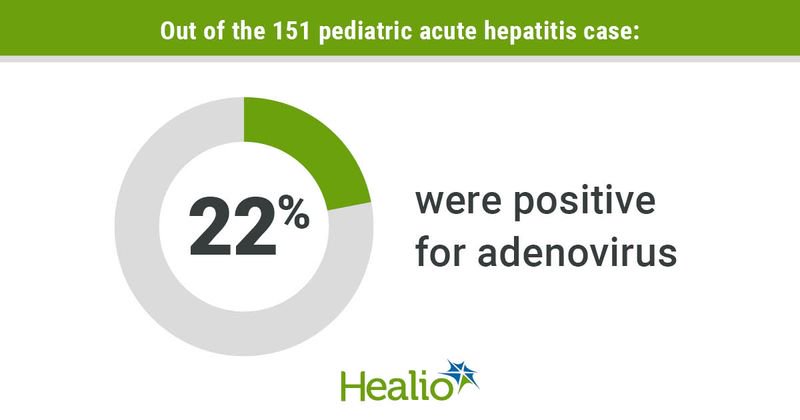No ‘singular definitive etiology’ found for acute hepatitis outbreak in children
WASHINGTON — Although adenovirus infection has been widely implicated in an outbreak of acute, severe hepatitis in children, data presented at The Liver Meeting found no “singular definitive etiology” for these cases.
“Beginning in October 2021, there were multiple clusters identified across the world of young children having a severe acute hepatitis and liver failure,” Rohit Kohli, MD, division chief of gastroenterology at the Children’s Hospital Los Angeles, University of Southern California, said during the presentation. “Some, unfortunately, progressed to liver failure, needing liver transplantation or death, and at that time, there were alarm bells ringing at the CDC and WHO. However, beyond these local reports, we didn’t understand completely what was going on as a community.”

Kohli and colleagues aimed to distinguish the clinical characteristics, histology and outcomes of the cases of young children with acute hepatitis through the Severe Hepatitis in Pediatric Patients International Registry, an international collaborative effort. From July 2022 through the end of October 2022, individual sites collected accrued data prospectively per WHO/CDC request into an IRB approved REDCap registry. Pediatric gastroenterologists from around the world were sent an email invitation through multiple listservs, of which 25 sites responded.
The researchers found 151 cases were reported with a median age of 41 months, of whom 54% were male and 40% were Hispanic. Kohli noted that case incidence peaked in May/June 2022, at which point 80% of cases reported gastrointestinal symptoms, with 27% reporting accompanying fever and 23% reporting respiratory symptoms. Among the cases, 10% of patients reported past SARS-CoV-2 infection within the previous year, and only 13% of patients had received COVID-19 vaccination. When the researchers examined peak laboratory biochemistry values, they observed that mean levels of AST and ALT “were in the 2000-3000 range,” an INR of 2.1 and an elevated total bilirubin of 9.24.
“The bigger question that everyone was asking was what was going on with viral etiology?” Kohli said.
After collating the data, the researchers determined that 13% of children had Epstein-Barr virus (EBV), 4% had cytomegalovirus (CMV), 22% adenovirus and 43% of patients reported a positive respiratory panel. More importantly, Kohli noted that there was “a lot of overlap,” with 3.9% of patients reporting positive for both EBV and adenovirus and 5% reporting hepatitis E virus IgM or a positive PCR, along with EBV and CMV.
“In addition, we had autoimmune markers that were reporting positive – ANA, anti-smooth muscle or anti-LKM – in a quarter of individuals,” Kohli said. “Whether these were just responses of the children to a [cytokine] storm, we don’t know.”
In their analysis, Kohli and colleagues found that 27.2% of the cases required ICU-level care, 2% were diagnosed by clinical criteria to have HLH, 5.2% underwent liver transplantation. Additionally, 32% of children had received steroids and were found to be more likely to undergo liver transplantation.
“We cannot identify a singular definitive etiology,” Kohli said. “Adenovirus has been talked about, but was only present in 22% in any shape or form of positivity in our cohort. CD8+ T cell severe acute hepatitis seems to be a predominant theme in histology which is not different from indeterminate acute liver failure publications in the past.”
He added: “What we would like to do is to continue our community surveillance and close cooperation within our centers to actually investigate further the indeterminate causes of acute liver failure or hepatitis that we have uncovered.”

